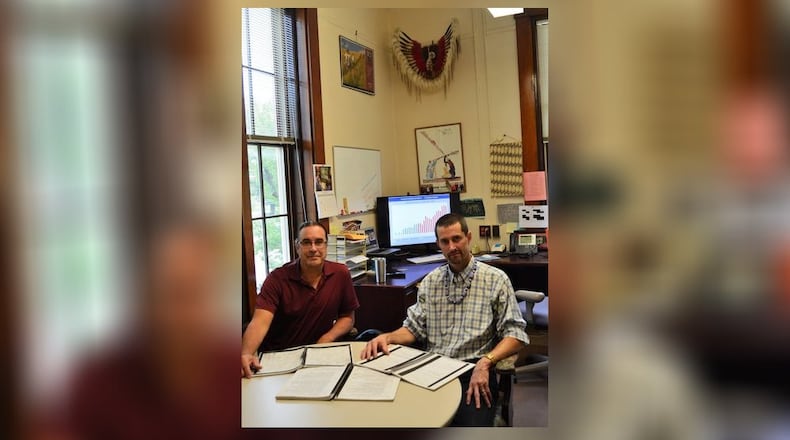This community-curated exhibition was developed with the Miami Tribe and will provide historical context and background to the contemporary revival of ribbonwork among the Miami people. Myaamia ribbonwork is an art form that produces beautifully complex geometric designs by layering, cutting, folding and sewing ribbon on clothing.
The exhibition will correspond to the 20th anniversary of the proposal to establish the Myaamia Project, and it runs in conjunction with the 2020 Myaamiaki Conference at Miami University, which will be held in April. The exhibition is free and open to the public. For more information, call (513) 529-2232 or visit www.MiamiOH.edu/Art-Museum.
George Ironstrack, assistant director/program director at the Myaamia Center at Miami University, shared more about the Myaamia Center at Miami and offered insight on the upcoming exhibition.
Q: Can you tell us a little bit about the Myaamia Center and the work you do?
A: The Myaamia Center is an initiative of the Miami Tribe of Oklahoma. We have two main purposes: to conduct in-depth research to assist tribal educational initiatives aimed at the preservation of language and culture and to expose undergraduate and graduate students at Miami University to tribal efforts in language and cultural revitalization.
I work on educational initiatives that focus on tribal youth language and culture, home learning, and the courses we teach for the Myaamia students at Miami University.
Q: What would you hope to communicate to the community and beyond?
A: That we are a living people with a past and not a people of the past.
Q: What is the significance of the Myaamia Ribbonwork exhibition?
A: The ribbonwork exhibition emerged out of discussions between Julie Olds, Cultural Resource Officer of the Miami Tribe of Oklahoma and Dr. Robert Wicks, director of the Miami University Art Museum. My understanding is that because of our long history of co-curating exhibitions at the Art Museum, that it was an ideal place for us to bring together key examples of historic ribbonwork from around North America.
Q: Why is ribbonwork an important part of the cultural tradition?
A: Over our long history as a people, we've always sought to decorate our clothes and our bodies in ways that we found pleasing. These visuals often incorporated repeating geometric patterns. Ribbonwork allowed Myaamia people to bring these patterns onto our clothing in powerful new ways that previous materials didn't allow.
Q: Can you walk us through the process of how a piece is created?
A: The process is quite complex and difficult to distill down to a few quick steps, which is why the Myaamia Center produced a volume on the art form. The length of time it takes to complete a piece depends on its size and complexity. An example of a "quick" project: producing a 4-by-8-inch strip with 12 diamonds requires eight ribbons and at least half a day to complete. Attaching the finished strip to a finished product, like a bag, could take another few hours. A complex project, like making matching strips to go on a pair of men's leggings, could take hundreds of hours and likely require a skilled ribbonworker to dedicate three to six months of work to complete.
Q: How is the university helping to preserve the traditions of the Miami Tribe?
A: The Miami Tribe of Oklahoma and Miami University have a relationship that stretches back to 1972, and over those 47 years we've developed an amazing degree of trust. That trust was key to the Tribe initiating a research office, the Myaamia Center, at the university. Our work is a part of a broader effort in language and cultural revitalization for the Tribe, but it's clear that certain parts of our effort, like language research, require the kinds of research resources that are best found at a top university like Miami. The collaboration between the two entities has been transformative for both the Tribe and University.
Q: What would you hope to convey through this exhibition?
A: For our non-Myaamia audience, we hope they leave with an appreciation of the artistic brilliance of our ancestors and with an understanding of us as a living people, who continue to build off of this legacy in ways that are meaningful to us today. For our Myaamia audience, we really want our community to reflect on the first peak art form in the 1830s and to think about how we can collectively produce a new generation of brilliant ribbonworkers in the next decade.
Q: Is there anything else you’d like to share?
A: As with everything the Center does, this exhibition is a team effort. I and my co-curator, Kara Strass, want to extend our deep gratitude to the team at the Miami University Art Museum for all of their work in making this exhibition come to fruition. "Mihši neewe" (big thanks) to Dr. Robert Wicks, Jason Shaiman, Laura Stewart, Mark DeGennaro, Cynthia Collins and Sherri Krazl.
About the Author
